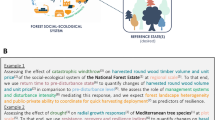Abstract
Lájer (2007) reviewed the use of statistical methods for the analysis of vegetation data and concluded that their assumptions are often violated. Most importantly, the vegetation data are usually not a random sample of vegetation, and consequently the statistical tests should not be used at all. Although we appreciate many concerns raised in Lájer’s paper, we find his conclusions far-fetched and inappropriate for practical use. In large-scale observational studies, it is practically impossible to define the sampled statistical population in the way that would allow for truly random sampling. As we are unable to ensure that any part of the population can appear in our sample with the same probability, we must try to avoid interaction between any bias imposed by the sampling procedure with the hypotheses we test. The same stance can also be taken in the case of datasets extracted from the databases of phytosociological relevés, where a substantial bias was introduced by phytosociologists’ prejudice in selection of sampling locations. We can hardly use this kind of data when testing hypotheses concerning absolute values of species richness or discontinuities in community variation, but there are also many important research hypotheses that can be tested even with the help of this data source. In fact, such voluminous databases are the only available source of data for exploring research questions referring to large spatial or temporal scales. We must also reject Lájer’s suggestion that application of descriptive, exploratory statistical methods is less harmful for datasets with sampling bias than application of tests of statistical hypotheses. Finally, we stress the difference between observational and experimental studies, because the rigor of sampling design should be respected much more in the case of latter ones.
Similar content being viewed by others
References
Anderson M.J. &Ter Braak C.J.F. (2003): Permutation tests for multi-factorial analysis of variance.J. Statist. Comput. Simul. 73: 85–113.
Borchsenius F., Nielsen P.K. &Lawesson J.E. (2004): Vegetation structure and diversity of an ancient temperate deciduous forest in SW Denmark.Pl. Ecol. 175: 121–135.
Diamond J. (1986): Overview: laboratory experiments, field experiments, and natural experiments. In:Diamond J. &Case TJ. (eds.),Community ecology, Harper & Row, New York, pp. 3–22.
Diekmann M., Kühne A. &Isermann M. (2007): Random vs non-random sampling: effects on patterns of species abundance, species richness and vegetation-environment relationships.Folia Geobot. 42: 179–190.
Gelman A., Carlin J.B., Stern H.S. &Rubin D.B. (1995):Bayesian data analysis. Chapman & Hall, London.
Gotteli N.J. &Ellison A.M. (2004):A primer of ecological statistics. Sinauer, Sunderland.
Grabherr G., Reiter K. &Williner W. (2003): Towards objectivity in vegetation classification: the example of the Austrian forests.Pl. Ecol. 169: 21–34.
Gurevitch J. & Hedges L.V. (2001): Meta-analysis. Combining the results of independent experiments. In:Scheiner S.M. & Gurevitch J. (eds.),Design and analysis of ecological experiments, Oxford University Press, pp. 347–369.
Hájková P. &Hájek M. (2004): Bryophyte and vascular plant responses to base-richness and water level gradients in Western CarpathianSphagnum-rich mires.Folia Geobot. 39: 335–351.
Hallgren E., Palmer M.W. &Milberg P. (1999): Data diving with cross-validation: an investigation of broad-scale gradients in Swedish weed communities.J. Ecol. 87: 1037–1051.
Hector A., Schmid B., Beierkuhnlein C., Caldeira M.C., Diemer M., Dimitrakopoulos P.G., Finn J.A., Freitas H., Giller P.S., Good J., Harris R., Hogberg P., Huss-Danell K., Joshi J., Jumpponen A., Korner C., Leadley P.W., Loreau M., Minns A., Mulder C.P.H., O’Donovan G., Otway S.J., Pereira J.S., Prinz A., Read D.J., Scherer-Lorenzen M., Schulze E.D., Siamantziouras A.S.D., Spehn E.M., Terry A.C., Troumbis A.Y., Woodward F.I., Yachi S. &Lawton J.H. (1999): Plant diversity and productivity experiments in European grasslands.Science 286: 1123–1127.
Johnson D.H. (1995): Statistical sirens: the allure of nonparametrics.Ecology 76: 1998–2000.
Knollová I., Chytrý M., Tichý L. &Hájek O. (2005): Stratified resampling of phytosociological databases: some strategies for obtaining more representative data sets for classification studies.J. Veg.Sci. 16: 479–486.
Lájer K. (2007): Statistical tests as inappropriate tools for data analysis performed on non-random samples of plant communities.Folia Geobot. 42: 115–122.
Legendre P., Dale M.R.T., Fortin M.J., Casgrain P. &Gurevitch J. (2005): Effects of spatial structures on the results of field experiments.Ecology 85: 3202–3214.
Potvin C. &Roff D.A. (1993): Distribution-free and robust statistical methods: viable alternatives to parametric statistics?Ecology 74: 1617–1628.
Smith S.M. (1995): Distribution-free and robust statistical methods: viable altneratives to parametric statistics?Ecology 76: 1997–1998.
Stewart-Oaten A. (1995): Rules and judgments in statistics: three examples.Ecology 76: 2001–2009.
Van der Putten W.H., Mortimer S.R., Hedlund K., Van Dijk C., Brown V.K., Lepš J., Rodriguez-Barrueco C., Roy J., Len T.A.D., Gormsen D., Korthals G.W., Lavorel S., Regina I.S. &Šmilauer P. (2000): Plant species diversity as a driver of early succession in abandoned fields: a multi-site approach.Oecologia 124: 91–99.
Author information
Authors and Affiliations
Corresponding author
Rights and permissions
About this article
Cite this article
Lepš, J., Šmilauer, P. Subjectively sampled vegetation data: Don’t throw out the baby with the bath water. Folia Geobot 42, 169–178 (2007). https://doi.org/10.1007/BF02893883
Received:
Revised:
Accepted:
Issue Date:
DOI: https://doi.org/10.1007/BF02893883




